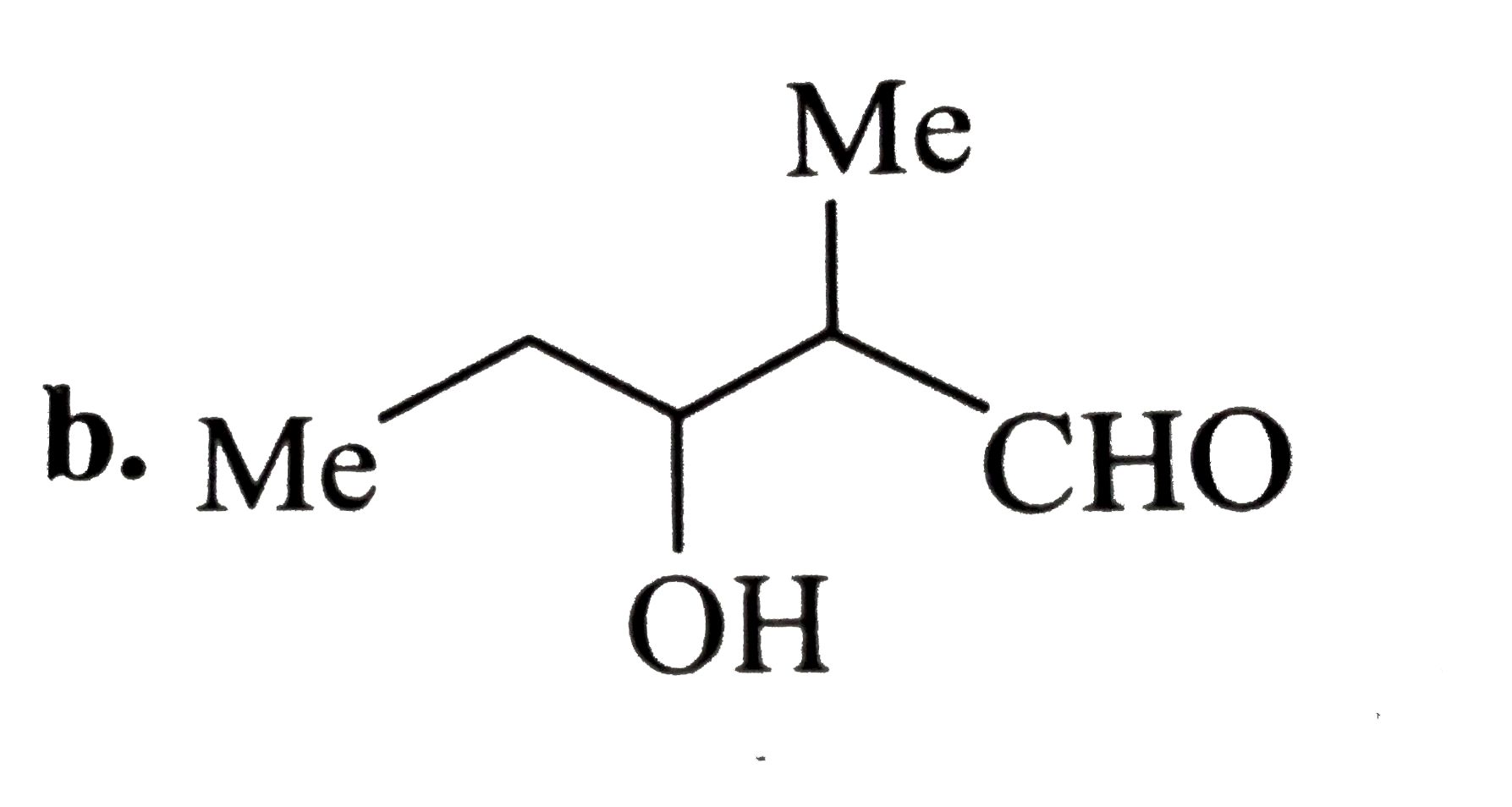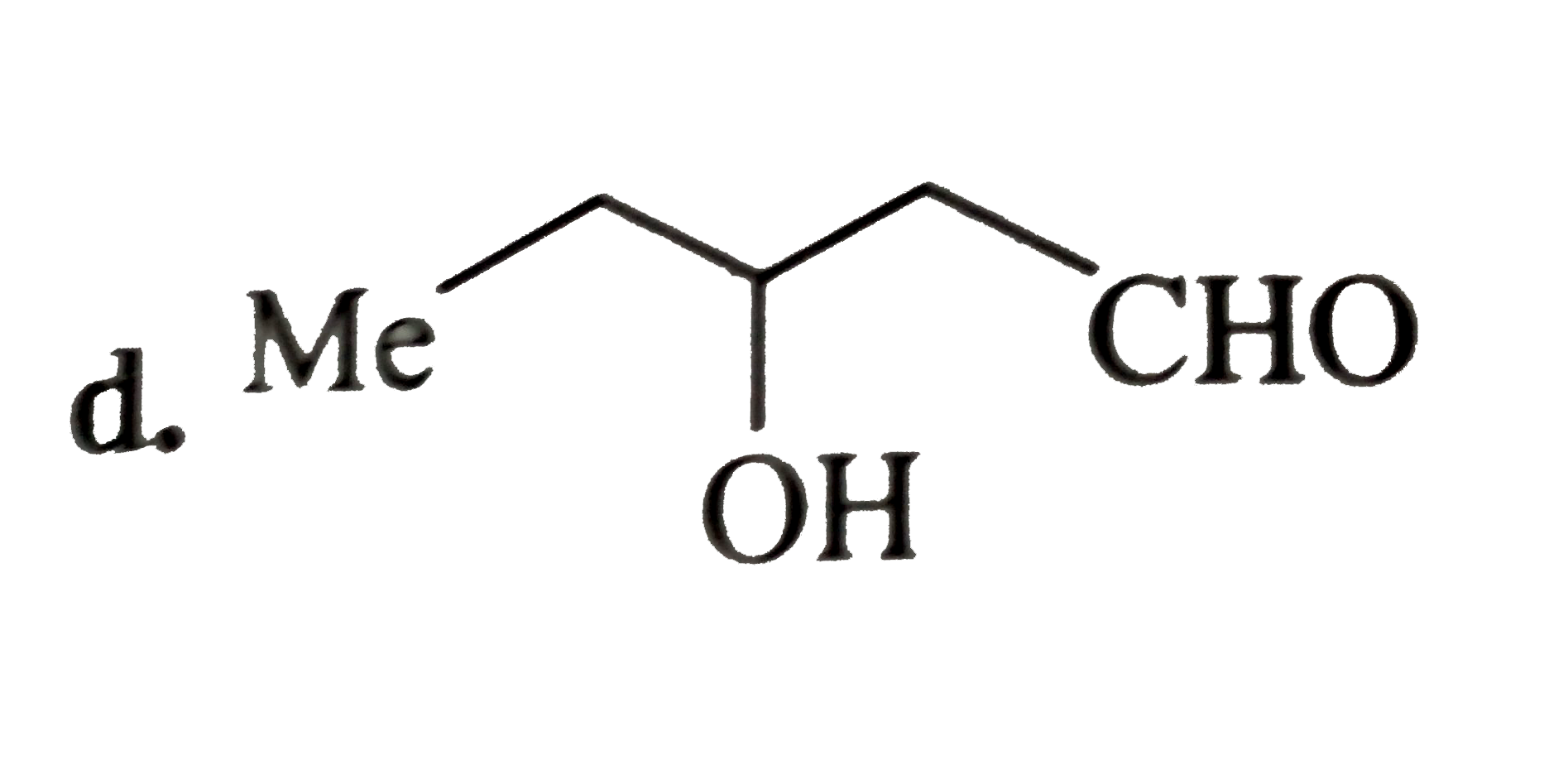Which of the following are crossed aldol products in the given reaction ?
MeCHO+MeCH2ΘOH−−→25∘C




The correct Answer is:C, D
To determine which of the products are crossed aldol products in the given reaction involving methyl aldehyde (MeCHO) and methyl ethyl ketone (MeCH₂CHO), we will follow these steps:
Step 1: Identify the Reactants
The reactants in this reaction are:
- Methyl aldehyde (MeCHO)
- Methyl ethyl ketone (MeCH₂CHO)
Step 2: Understand the Aldol Reaction
In an aldol reaction, an aldehyde or ketone with at least one alpha hydrogen undergoes deprotonation to form an enolate ion, which then attacks the carbonyl carbon of another aldehyde or ketone. This leads to the formation of a β-hydroxy aldehyde or ketone.
Step 3: Form the Enolate Ion
For methyl aldehyde (MeCHO), the alpha carbon is the carbon adjacent to the carbonyl group. The alpha hydrogen can be removed to form the enolate ion:
- Enolate ion from MeCHO: MeC(=O)− (the negative charge is on the carbon adjacent to the carbonyl)
Step 4: Attack the Carbonyl of the Other Reactant
The enolate ion formed from MeCHO can attack the carbonyl carbon of methyl ethyl ketone (MeCH₂CHO):
- The nucleophilic attack results in the formation of a β-hydroxy aldehyde.
Step 5: Identify the Product
The product formed from this reaction is:
- 3-hydroxy-2-methylbutanal (which can also be represented as CH3CH(OH)CH2CHO).
Step 6: Consider the Reverse Reaction
Now consider the reverse scenario where the enolate ion from methyl ethyl ketone attacks the carbonyl carbon of methyl aldehyde:
- This will also yield a different β-hydroxy aldehyde.
Step 7: List the Products
The two crossed aldol products formed from the reaction are:
1. 3-hydroxy-2-methylbutanal (from MeCHO attacking MeCH₂CHO)
2. 3-hydroxypentanal (from MeCH₂CHO attacking MeCHO)
Conclusion
Thus, the crossed aldol products formed in the reaction are:
- Option C: 3-hydroxy-2-methylbutanal
- Option D: 3-hydroxypentanal
The reactants in this reaction are:
- Methyl aldehyde (MeCHO)
- Methyl ethyl ketone (MeCH₂CHO)
In an aldol reaction, an aldehyde or ketone with at least one alpha hydrogen undergoes deprotonation to form an enolate ion, which then attacks the carbonyl carbon of another aldehyde or ketone. This leads to the formation of a β-hydroxy aldehyde or ketone.
For methyl aldehyde (MeCHO), the alpha carbon is the carbon adjacent to the carbonyl group. The alpha hydrogen can be removed to form the enolate ion:
- Enolate ion from MeCHO: MeC(=O)− (the negative charge is on the carbon adjacent to the carbonyl)
The enolate ion formed from MeCHO can attack the carbonyl carbon of methyl ethyl ketone (MeCH₂CHO):
- The nucleophilic attack results in the formation of a β-hydroxy aldehyde.
The product formed from this reaction is:
- 3-hydroxy-2-methylbutanal (which can also be represented as CH3CH(OH)CH2CHO).
Now consider the reverse scenario where the enolate ion from methyl ethyl ketone attacks the carbonyl carbon of methyl aldehyde:
- This will also yield a different β-hydroxy aldehyde.
The two crossed aldol products formed from the reaction are:
1. 3-hydroxy-2-methylbutanal (from MeCHO attacking MeCH₂CHO)
2. 3-hydroxypentanal (from MeCH₂CHO attacking MeCHO)
Thus, the crossed aldol products formed in the reaction are:
- Option C: 3-hydroxy-2-methylbutanal
- Option D: 3-hydroxypentanal
Topper's Solved these Questions
- ALIPHATIC AND AROMATIC ALDEHYDES AND KETONESBOOK - CENGAGE CHEMISTRY ENGLISHCHAPTER - ALIPHATIC AND AROMATIC ALDEHYDES AND KETONESEXERCISE - Exercises Single Correct
71 Videos
- ALIPHATIC AND AROMATIC ALDEHYDES AND KETONESBOOK - CENGAGE CHEMISTRY ENGLISHCHAPTER - ALIPHATIC AND AROMATIC ALDEHYDES AND KETONESEXERCISE - Exercises Assertion-Reasoning
6 Videos
- ALIPHATIC AND AROMATIC ALDEHYDES AND KETONESBOOK - CENGAGE CHEMISTRY ENGLISHCHAPTER - ALIPHATIC AND AROMATIC ALDEHYDES AND KETONESEXERCISE - Exercises Linked Comprehension
59 Videos
- ALCOHOL,PHENOL AND ETHERSBOOK - CENGAGE CHEMISTRY ENGLISHCHAPTER - ALCOHOL,PHENOL AND ETHERSEXERCISE - Archives Analytical And Descriptive
15 Videos
- APPENDIX INORGANIC VOLUME 2BOOK - CENGAGE CHEMISTRY ENGLISHCHAPTER - APPENDIX INORGANIC VOLUME 2EXERCISE - Short Answer Type
179 Videos
Similar Questions
Complete the following reactions:
PhCHO+CH3NO2ΘOH−−→Δ(A)
View SolutionWhich of the following is not the mechanism of Cannizzaro reaction ?
2PhCHOΘOH−−→PhCH2OH+PhCOOΘ
View SolutionWhich of the statements are correct about the following reactions ?
MeCHO+[Ag(NH3)2]⊕+ΘOH+→MeCOOΘ+Ag
View SolutionWrite the final product of the following reaction :
CH3−CH∣OH−CH3Cu/573K−−−−−→
View SolutionWrite the product of the following reaction :
CH2=CH−CH2−OHPCC−−→
View SolutionWhat would be the major products in the following reactions:
CH3−CH3∣C∣CH3−CH2BrC2H5OH−−−−→Δ
View SolutionWhat would be the major products in the following reactions:
CH3−CH3∣C∣CH3−CH2BrC2H5OH−−−−→Δ
View SolutionWhat would be the major products in the following reactions:
CH3−CH3∣C∣CH3−CH2BrC2H5OH−−−−→Δ
View SolutionThe product of reaction CH3CH2OH573K−−−−−→Cu ? Is :
View SolutionThe product obtained in the reaction R∣OHCH−CH2O∣∣C−OHΔ−−→
? Is :
View Solution
